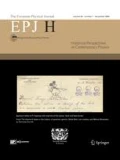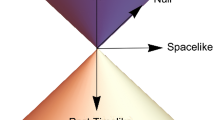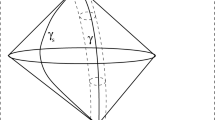Abstract
Pascual Jordan’s path-breaking role as the protagonist of quantum field theory (QFT) is recalled and his friendly dispute with Dirac’s particle-based relativistic quantum theory is presented as the start of the field-particle conundrum which, though in modified form, persists up to this date. Jordan had an intuitive understanding that the existence of a causal propagation with finite propagation speed in a quantum theory led to radically different physical phenomena than those of QM. The conceptional-mathematical understanding for such an approach began to emerge only 30 years later. The strongest link between Jordan’s view of QFT and modern “local quantum physics” is the central role of causal locality as the defining principle of QFT as opposed to the Born localization in QM. The issue of causal localization is also the arena where misunderstandings led to a serious derailment of large part of particle theory e.g. the misinterpretation of an infinite component pointlike field resulting from the quantization of the Nambu-Goto Lagrangian as a spacetime quantum string. The new concept of modular localization, which replaces Jordan’s causal locality, is especially important to overcome the imperfections of gauge theories for which Jordan was the first to note nonlocal aspects of physical(not Lagrangian) charged fields. Two interesting subjects in which Jordan was far ahead of his contemporaries will be presented in two separate sections.
Similar content being viewed by others
References
D. Hoffmann, J. Ehlers, J. Renn, Pascual Jordan (1902–1980), Mainzer Symposium zum 100. Geburtstag. Max Planck Institute for History of Science, preprint 329 (2007)
Bert Schroer, Pascual Jordan, Biographical notes, his contributions to quantum mechanics and his role as a protagonist of quantum field theory, in Hoffmann et al. (2007), 47–68
Wolf D. Beiglböck, Ernst Pascual Jordan als Autor wissenschaftlicher und allgemeinbildender Schriften, pp. 145–206. in D. Hoffmann, J. Ehlers, J. Renn, Pascual Jordan (1902–1980), Mainzer Symposium zum 100. Geburtstag. Max Planck Institute for History of Science, preprint 329 (2007)
Max Born, Werner Heisenberg, Pascual Jordan, Zur Quantenmechanik II, Zeitschrift für Physik 35, 557–615 (1926)
Albert Einstein, Zur Quantentheorie der Strahlung, Physikalische Zeitschrift 18, 121–128 (1917). English translation, in Van der Waerden (1968), 63–77
Anthony Duncan, Michel Janssen, Pascual Jordan’s resolution of the conundrum of the wave-particle duality of light, arXiv:0709.3812
Bert Schoer, The Einstein-Jordan conundrum and its relation to ongoing foundational research in local quantum physics, arXiv:1101.0569
Pascual Jordan, O. Klein, Zum Mehrkörperproblem in der Quantentheorie, Zeitschrift für Physik 45, 751–765 (1927)
Bert Schroer, Localization and the interface between quantum mechanics, quantum field theory and quantum gravity I (The two antagonistic localizations and their asymptotic compatibility), Studies in History and Philosophy of Modern Physics 41, 104–127 (2010)
Bert Schroer, Localization and the interface between quantum mechanics, quantum field theory and quantum gravity II (The search of the interface between QFT and QG), Studies in History and Philosophy of Modern Physics 41, 293–308 (2010)
Bert Schroer, Bondi-Metzner-Sachs symmetry, holography on null-surfaces and area proportionality of “light-slice” entropy, Foundations of Physics 41, 204–241 (2011)
Pascual Jordan, Zur Theorie der Quantenstrahlung, Zeitschrift für Physik 30, 297–319 (1924)
Albert Einstein, Bemerkungen zu P. Jordans: Zur Theorie der Quantenstrahlung, Zeitschrift für Physik 31, 784–785 (1925)
W. Heitler, The quantum theory of radiation (Clarendon Press, Oxford, 1936)
Eugene Paul Wigner, On unitary representations of the inhomogeneous Lorentz group, Ann. Math. 40, 149–204 (1939)
F. Coester, W.N. Polyzou, Relativistic quantum-mechanics of particles with direct interactions, Phys. Rev. D 26, 1348–1367 (1982)
Steven Weinberg, What is Quantum Field Theory and what did we think it was? pp. 241–251, in Conceptual Foundations of Quantum Field Theory (ed. Tian Yu Cao, Cambridge University Press, 1999)
Pascual Jordan, Kausalitaet und Statistik in der Modernen Physik, Die Naturwissenschaften 15, 105–110 (1927)
H. Halvorson, Reeh-Schlieder defeats Newton-Wigner: on alternative localization schemes in quantum field theory, Philos. Sci. 68, 111–133 (2001)
Pascual Jordan, Wolfgang Pauli, Zur Quantenelektrodynamik ladungsfreier Felder, Zeitschrift für Physik 47, 151–173 (1928)
Werner Heisenberg, Über die mit der Entstehung von Materie aus Strahlung verknüpften Ladungsschwankungen, Verhandlungen der Sächsischen Akademie der Wissenschaften zu Leipzig 86, 317–322 (1934)
W.H. Furry, J. Robert Oppenheimer, On the theory of the electron and positive, Phys. Rev. 45, 245–262 (1934)
Bert Schroer, A critical look at 50 years particle theory from the perspective of the crossing property, Found. Phys. 40, 1800–1857 (2010)
B. Bakamijan, L.H. Thomas, Relativistic particle dynamics II, Phys. Rev. 92, 1300–1310 (1953)
F. Coester, Scattering theory for relativistic particles, Helvetica Phys. Acta 38, 7–28 (1965)
N.S. Sokolov, Interacting relativistic particles, Doklady Akad. Nauk USSR 233, 575–592 (1977)
W.N. Polyzou, Equivalent Hamiltonians. Phys. Rev. C. 82, 014002 (2010)
W.N. Polyzou, Cluster properties in relativistic quantum mechanics of N-particle systems, J. Math. Phys. 43, 6024–6038 (2002)
S. Weinberg, The Quantum Theory of Fields I (Cambridge University Press, 1995)
S.S. Schweber, QED and the men who made it (Dyson, Feynman, Schwinger and Tomonaga, Princeton University Press, 1994)
Rudolf Haag, Local Quantum Physics (Springer, 1996)
H.-J. Borchers, On revolutionizing quantum field theory with Tomita’s modular theory, J. Math. Phys. 41, 3604–3873 (2000)
W.G. Unruh, Notes on black hole evaporation, Phys. Rev. D 14, 870–892 (1976)
J.J. Bisognano, E.H. Wichmann, On the duality condition for quantum fields, J. Math. Phys. 17, 303–321 (1976)
G.L. Sewell, PCT and gravitationally induced, Ann. Phys. 141, 201–224 (1982)
Bert Schroer, Modular localization and the bootstrap-formfactor program, Nucl. Phys. B 499, 547–568 (1997)
R. Brunetti, D. Guido, R. Longo, Modular localization and Wigner particles, Rev. Math. Phys. 14, 759–785 (2002)
L. Fassarella, Bert Schroer, Wigner particle theory and local quantum physics, J. Phys. A 35, 9123–9164 (2002)
Jens Mund, Bert Schroer, Jakob Yngvason, String-localized quantum fields and molecular localization, Commun. Math. Phys. 268, 621–672 (2006)
Jens Mund, Modular localization of massive particles with “any” spin in d = 2 + 1 dimensions, J. Math. Phys. 44, 2037–2057 (2003)
R. Longo, Simple proof of existence of modular automorphisms in approximately finite dimensional von Neumann algebras, Pacific J. Math. 75, 199–205 (1978)
R.F. Streater, A.S. Wightman, PCT, Spin and Statistics and all that (New York, Benjamin, 1964)
Jens Mund, The Bisognano-Wichmann theorem for massive theories, Ann. Henri Poincare 2, 907–926 (2001)
Alain Connes, Caractérisation des espaces vectoriels ordonnées sous-jacents aux algèbres de von Neumann, Ann. Inst. Fourier 24, 121–155 (1974)
Bert Schroer, Unexplored regions in QFT and the conceptual foundations of the Standard Model, arXiv:1006.3543
Ozwaldo Zapata, On Facts in Superstring Theory, A Case Study: The AdS/CFT Correspondence, arXiv:0905.1439
Ozwaldo Zapata, Spinning the superweb, essays on the history of string theory, http://www.spinningthesuperweb.blogspot.com/
K. Pohlmeyer, A group-theoretical approach to the quantization of the free relativistic closed string, Phys. Lett. B 119, 100–104 (1982)
Y. Nambu, Lectures at the Copenhagen Symposium, 1970, unpublished
Tetsuo Goto, Relativistic quantum mechanics of one-dimensional mechanical continuum and subsidiary condition of dual resonance model, Progr. Theor. Phys. 46, 1560–1569 (1971)
E. Martinec, The light-cone in string theory, Class. Quant. Grav. 10, 187–192 (1993)
D.A. Lowe, Causal properties of free string field-theory, Phys. Lett. B 326, 223–230 (1994)
Paolo Di Vecchia, The birth of string theory, Lect. Not. Phys. 737, 59–118 (2008)
E. Witten, Global aspects of current algebra, Nucl. Phys. B 223, 422–432 (1983)
Y. Kawahigashi, R. Longo, U. Pennig, K.-H. Rehren, The classification of non-local chiral CFT with c < 1, Commun. Math. Phys. 271, 375–385 (2007)
Gandalf Lechner, On the Construction of Quantum Field Theories with Factorizing S-Matrices, PhD thesis, arXiv:math-ph/0611050
Gerhard Mack, D-dimensional Conformal Field Theories with anomalous dimensions as Dual Resonance Models, arXiv:0909.1024,
Gerhard Mack, D-independent representations of conformal field theories in D dimensions via transformations to auxiliary dual resonance models, Scalar amplitude, arXiv:0907:2407
N.N. Bogoliubov, A. Logunov, A.I. Oksak, I.T. Todorov, General principles of quantum field theory (Dordrecht Kluwer, 1990)
Detlev Buchholz, Klaus Fredenhagen, Locality and the structure of particle states, Commun. Math. Phys. 84, 1–54 (1982)
Pascual Jordan, The Present State of Quantum Electrodynamics, in Talks and Discussions of the Theoretical-Physical Conference in Kharkov (May 19.–25., 1929)
Pascual Jordan, The current position of quanta electro dynamics, Physik. Zeitschr. 30, 700–712 (1929)
Pascual Jordan, Zur Quantenelektrodynamik. III. Eichinvariante Quantelung und Diracsche Magnetpole, Zeitschrift für Physik 97, 535–537 (1935)
Roman W. Jackiw, Dirac’s magnetic monopoles (again), Int. J. Mod. Phys. A 19S1, 137–143 (2004)
Rudolf Haag, Discussion of the ‘axioms’ and the asymptotic properties of a local field theory with composite particles (historical document), Eur. Phys. J. H 35, 243–253 (2010)
H. Epstein, V. Glaser, Role of locality in perturbation-theory, Ann. Inst. H. Poincaré A 19, 211–295 (1973)
S. Doplicher, J.E. Roberts, Why there is a field algebra with a compact gauge group describing the superselection structure in particle physics, Commun. Math. Phys. 131, 51–107 (1990)
Bert Schroer, Modular Wedge Localization and the d = 1 + 1 Formfactor Program, Ann. Phys. 295, 190–223 (1999)
Pascual Jordan, Beiträge zur Neutrinotheorie des Lichts III, Zeitschrift für Physik 105, 229–231 (1937)
Pascual Jordan, Beiträge zur Neutrinotheorie des Lichts II, Zeitschrift für Physik 105, 114–121 (1937)
Pascual Jordan, Beiträge zur Neutrinotheorie des Lichts I, Zeitschrift für Physik 102, 243–252 (1937)
Pascual Jordan, Zur Neutrinotheorie des Lichtes, Zeitschrift für Physik 93, 464–472 (1935)
B. Klaiber, The Thirring Model, edited by O.A. Barut, W.E. Brittin, Lectures in Theoretical Physics (Gordon and Breach, New York, 1968), volume 10 A, pp. 141–176
V. Fock, Inconsistency of the neutrino theory of light, Nature 136, N3502 (1936) 1011–1012
Julian Schwinger, Field theory commutators, Phys. Rev. Lett. 3, 296–297 (1959)
Detlev Buchholz, Gerhard Mack, Ivan Todorov, The current algebra on the circle as a germ of local field theories, Nucl. Phys. B (Proc. Suppl.) 5, 20–56 (1988)
A. Pais, Inward Bound (Clarendon Press, Oxford University Press, 1986)
S. Doplicher, R. Longo, Standard and split inclusions of von Neumann algebras, Invent. Mat. 75, 493–536 (1984)
S. Hollands, R.E. Wald, Quantum Field Theory Is Not Merely Quantum Mechanics Applied to Low Energy Effective Degrees of Freedom, General Relativity and Gravitation 36, 2595–2603 (2004)
Pascual Jordan, Anschauliche Quantentheorie (Springer, Berlin, 1936)
Pascual Jordan, Eugene Paul Wigner, Über das Paulische Äquivalenzverbot, Zeitschrift für Physik 47, 631–651 (1928)
Julian Schwinger, Gauge invariance and mass, II. Phys. Rev. 128, 2425–2429 (1962)
Julian Schwinger, Gauge theories of Vector particles. Theoretical Physics (Trieste Lectures, 1962) (I.A.E.A., Vienna 1963), p. 89
L.V. Belvedere, J.A. Swieca, K.D. Rothe, Bert Schroer, Generalized Twodimensional Abelian Gauge Theories and Confinement, Nucl. Phys. B 153, 112–140 (1979)
Bert Schroer, Two dimensional models as testing ground for principles and concepts of local quantum physics, Ann. Phys. 321, 435–479 (2006)
Bert Schroer, Infrateilchen in des Quantenfeldtheorie, Fortschr. Phys. 11, 1–31 (1963), Bert Schroer, A note on infraparticles and unparticles, arXiv:0804.3563
Pascual Jordan, Zur Quantenelektrodynamik, I. Eichinvariante Operatoren, Zeitschrift für Physik 95, 202–209 (1935)
O. Steinmann, A Jost-Schroer theorem for string fields, Commun. Math. Phys. 87, 259–264 (1982)
J. Langerholc, Bert Schroer. Can current – operators determine a complete theory? Commun. Math. Phys. 4, 123–136 (1967)
S. Jacobs, Gauge bridges in classical field theory, DESY-THESIS-2009-009, http://unith.desy.de/research/aqft/diplomatheses/
P. Leyland, J. Roberts, D. Testard, Duality for Quantum Free Fields, unpublished notes, CNRS Marseille, (1978)
Detlev Buchholz, Gauss law and the infraparticle problem, Phys. Lett. B 174, 331–334 (1986)
Felix Bloch, A. Nordsiek, Note on the radiation field of the electron, Phys. Rev. 52, 54–59 (1937)
Rudolf Haag, Bert Schroer, Postulates of quantum field theory, J. Math. Phys. 3, 248–256 (1962)
G.C. Hegerfeldt, Causality problems in Fermi’s two atom system, Phys. Rev. Lett. 72, 596–599 (1994)
Detlev Buchholz, J. Yngvason, There are no causality problems for Fermi’s two atom system, Phys. Rev. Lett. 73, 613–616 (1994)
Matthew Norton Wise, Pascual Jordan: quantum mechanics, psychology, National Socialism, in: Science, Technology and National Socialism, edited by Monika Renneberg, Mark Walker (Cambridge, 1994), pp. 224–254
J. Cornwell, Hitler’s scientists, Science, War and the Devil’s Pact, Viking N4 (2000)
Richard H. Beyler, Targeting the organism, The scientific and cultural context of Pascual Jordan’s quantum biology, 1932–1947, Isis 87, 248–273 (1996)
Olivier Darrigol, The origin of quantized matter waves, Hist. Stud. Phys. Sci. 16/2, 197–253 (1986)
Author information
Authors and Affiliations
Corresponding author
Additional information
Dedicated to my teacher and role model: Rudolf Haag.
Rights and permissions
About this article
Cite this article
Schroer, B. Pascual Jordan’s legacy and the ongoing research in quantum field theory⋆. EPJ H 35, 377 (2011). https://doi.org/10.1140/epjh/e2011-10015-8
Received:
Published:
DOI: https://doi.org/10.1140/epjh/e2011-10015-8




